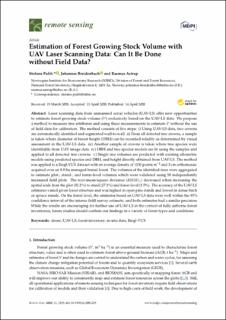| dc.contributor.author | Puliti, Stefano | |
| dc.contributor.author | Breidenbach, Johannes | |
| dc.contributor.author | Astrup, Rasmus Andreas | |
| dc.date.accessioned | 2020-12-09T10:39:51Z | |
| dc.date.available | 2020-12-09T10:39:51Z | |
| dc.date.created | 2020-08-26T09:44:06Z | |
| dc.date.issued | 2020-04-14 | |
| dc.identifier.citation | Remote Sensing. 2020, 12 (8), . | en_US |
| dc.identifier.issn | 2072-4292 | |
| dc.identifier.uri | https://hdl.handle.net/11250/2712569 | |
| dc.description.abstract | Laser scanning data from unmanned aerial vehicles (UAV-LS) offer new opportunities to estimate forest growing stock volume ( V ) exclusively based on the UAV-LS data. We propose a method to measure tree attributes and using these measurements to estimate V without the use of field data for calibration. The method consists of five steps: i) Using UAV-LS data, tree crowns are automatically identified and segmented wall-to-wall. ii) From all detected tree crowns, a sample is taken where diameter at breast height (DBH) can be recorded reliably as determined by visual assessment in the UAV-LS data. iii) Another sample of crowns is taken where tree species were identifiable from UAV image data. iv) DBH and tree species models are fit using the samples and applied to all detected tree crowns. v) Single tree volumes are predicted with existing allometric models using predicted species and DBH, and height directly obtained from UAV-LS. The method was applied to a Riegl-VUX data set with an average density of 1130 points m−2 and 3 cm orthomosaic acquired over an 8.8 ha managed boreal forest. The volumes of the identified trees were aggregated to estimate plot-, stand-, and forest-level volumes which were validated using 58 independently measured field plots. The root-mean-square deviance ( RMSD% ) decreased when increasing the spatial scale from the plot (32.2%) to stand (27.1%) and forest level (3.5%). The accuracy of the UAV-LS estimates varied given forest structure and was highest in open pine stands and lowest in dense birch or spruce stands. On the forest level, the estimates based on UAV-LS data were well within the 95% confidence interval of the intense field survey estimate, and both estimates had a similar precision. While the results are encouraging for further use of UAV-LS in the context of fully airborne forest inventories, future studies should confirm our findings in a variety of forest types and conditions. | en_US |
| dc.language.iso | eng | en_US |
| dc.publisher | MDPI, Basel, Switzerland | en_US |
| dc.rights | Navngivelse 4.0 Internasjonal | * |
| dc.rights.uri | http://creativecommons.org/licenses/by/4.0/deed.no | * |
| dc.title | Estimation of Forest Growing Stock Volume with UAV Laser Scanning Data: Can It Be Done without Field Data? | en_US |
| dc.type | Peer reviewed | en_US |
| dc.type | Journal article | en_US |
| dc.description.version | publishedVersion | en_US |
| dc.rights.holder | © 2020 by the authors | en_US |
| dc.source.pagenumber | 19 | en_US |
| dc.source.volume | 12 | en_US |
| dc.source.journal | Remote Sensing | en_US |
| dc.source.issue | 8 | en_US |
| dc.identifier.doi | 10.3390/RS12081245 | |
| dc.identifier.cristin | 1825197 | |
| dc.source.articlenumber | 1245 | en_US |
| cristin.ispublished | true | |
| cristin.fulltext | original | |
| cristin.qualitycode | 1 | |

